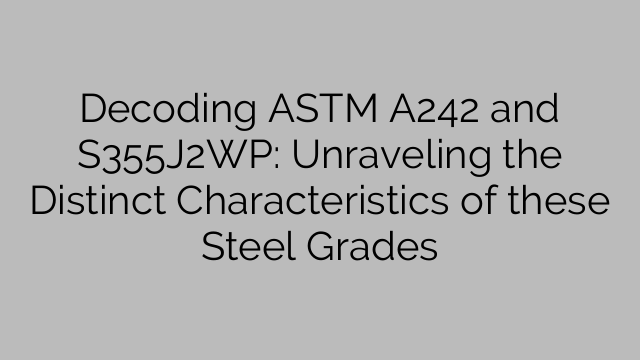Decoding ASTM A242 and S355J2WP: Unraveling the Distinct Characteristics of these Steel Grades
Steel is undoubtedly one of the most versatile and widely used materials in various industries. From construction to manufacturing, steel plays a crucial role in ensuring the strength, durability, and reliability of structures and components. However, not all steel grades are created equal, and understanding their distinct characteristics is essential for selecting the right grade for specific applications. In this article, we will decode two popular steel grades – ASTM A242 and S355J2WP – to unravel their unique properties and applications.
1. ASTM A242:
ASTM A242 is a high-strength, low-alloy structural steel grade predominantly used in outdoor structural applications. It offers exceptional atmospheric corrosion resistance, making it an ideal choice for outdoor structures such as bridges, buildings, and sculptures. ASTM A242 steel is composed of copper, chromium, nickel, and a small amount of phosphorus, which enhances its ability to resist corrosion. This steel grade surpasses other conventional carbon steels in terms of its corrosion resistance, thus making it suitable for environments with high exposure to atmospheric conditions.
ASTM A242 steel exhibits a tensile strength of 70,000 psi and a yield strength of 50,000 psi, providing excellent strength and durability. Its unique composition allows it to develop a dense oxide layer on its surface, known as the “patina.” This patina acts as a protective barrier against corrosion and reduces the need for maintenance and repainting. Furthermore, this steel grade retains its strength even at elevated temperatures, making it suitable for a wide range of applications.
2. S355J2WP:
S355J2WP is a weather-resistant steel grade that offers superior corrosion resistance compared to standard carbon steels. It is primarily used in structural and architectural applications, where exposure to harsh weather conditions is a concern. This grade is highly sought after for its ability to withstand the effects of weathering, including the formation of rust, which can significantly impact the integrity of structures.
The “WP” in S355J2WP stands for the words “Weathering Steel with Improved Atmospheric Corrosion Resistance.” This indicates its exceptional resistance to atmospheric corrosion, particularly in environments with high levels of pollutants, saltwater, or extreme temperature variations. The key elements in S355J2WP steel are chromium, copper, and phosphorus, which form a protective patina on the surface when exposed to the atmosphere. This patina not only provides corrosion resistance but also adds an attractive rustic appearance to structures.
In terms of mechanical properties, S355J2WP has a minimum yield strength of 355 N/mm² and a minimum tensile strength of 510 N/mm². These properties make it suitable for load-bearing structures subjected to high-stress conditions.
결론:
ASTM A242 and S355J2WP are two steel grades with exceptional corrosion resistance and are widely used in outdoor applications. While ASTM A242 is known for its excellent atmospheric corrosion resistance, S355J2WP stands out for its superior weathering properties that can withstand extreme weather conditions. Both steel grades offer strength, durability, and reduced maintenance costs, making them popular choices for various structural and architectural projects.
When selecting between ASTM A242 and S355J2WP, it is important to evaluate the specific requirements of the application and consider factors such as environmental conditions, load-bearing capacity, and aesthetics. By understanding the distinct characteristics of these steel grades, professionals can make informed decisions and ensure the longevity and performance of their structures.

